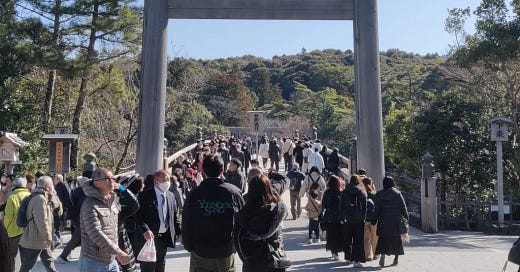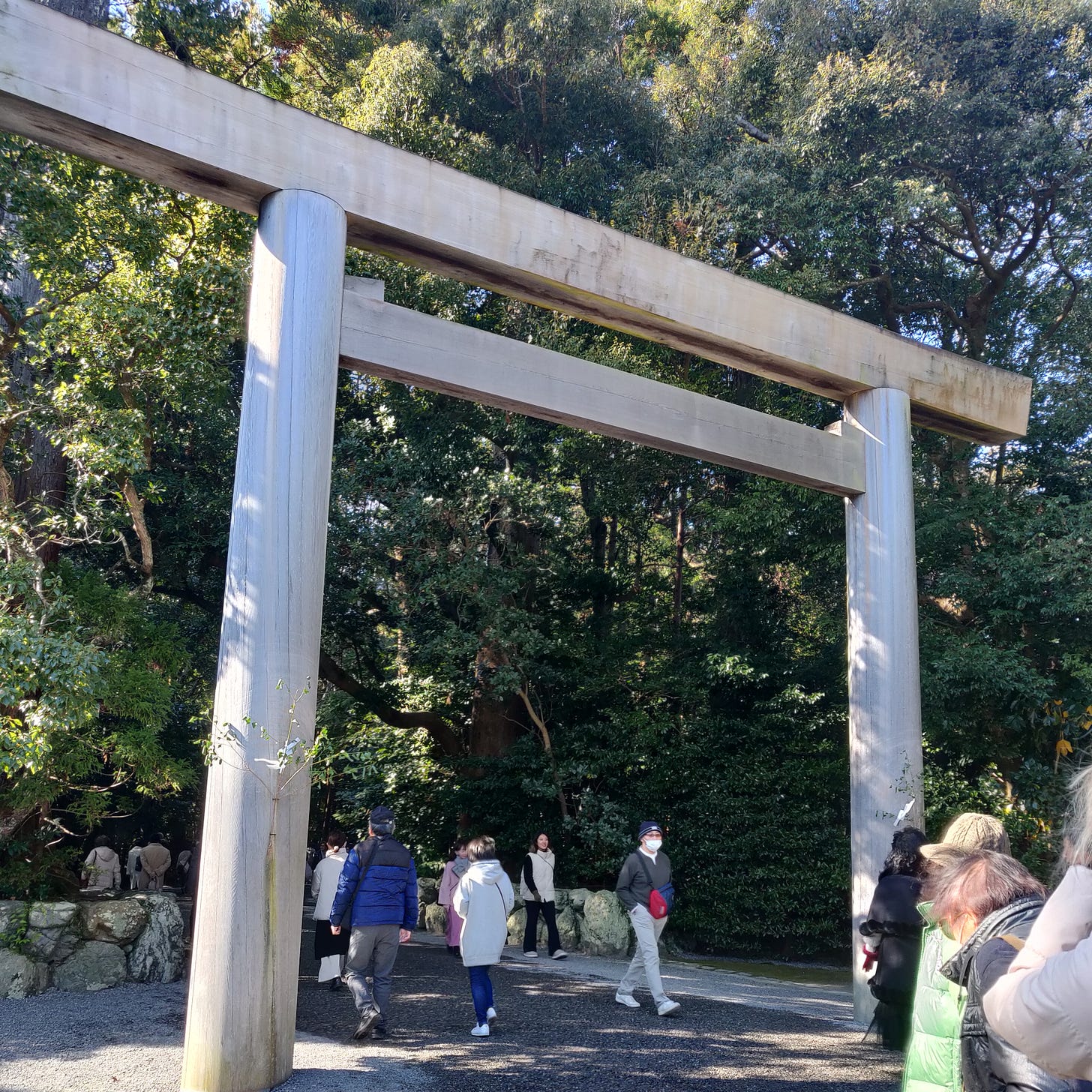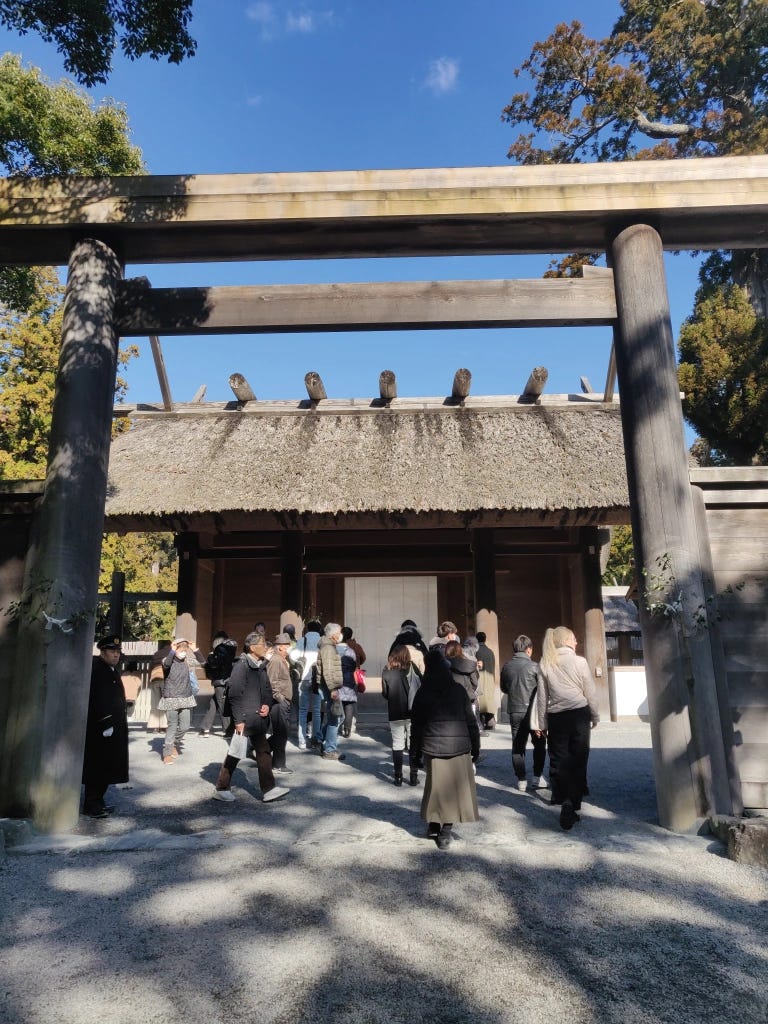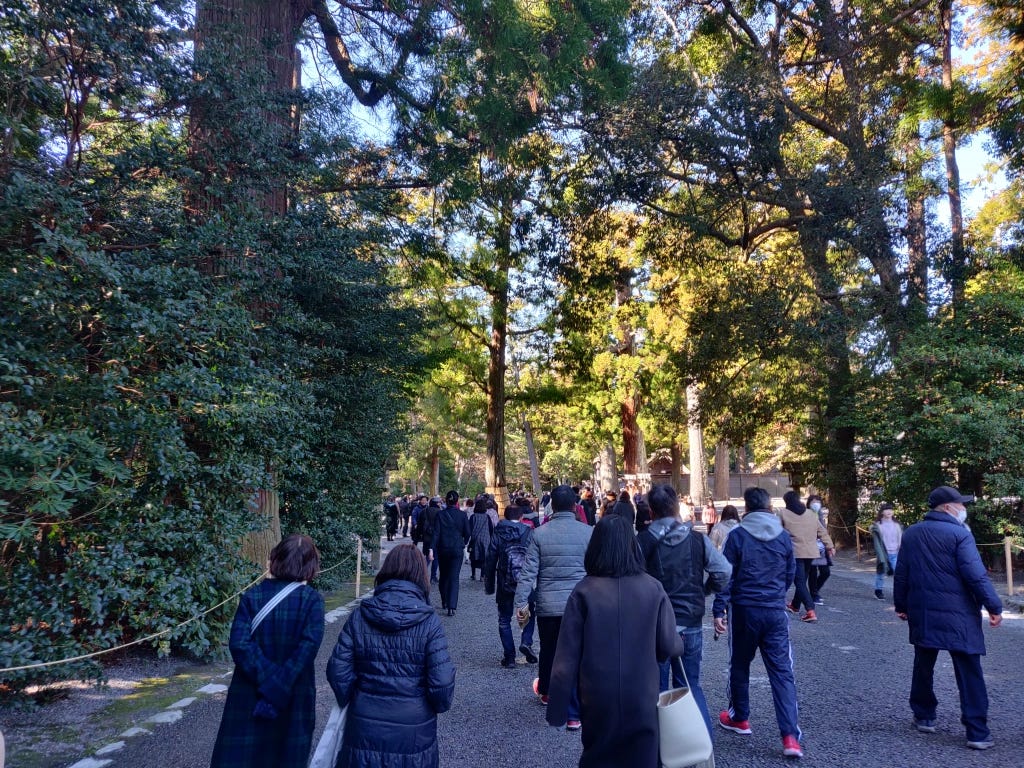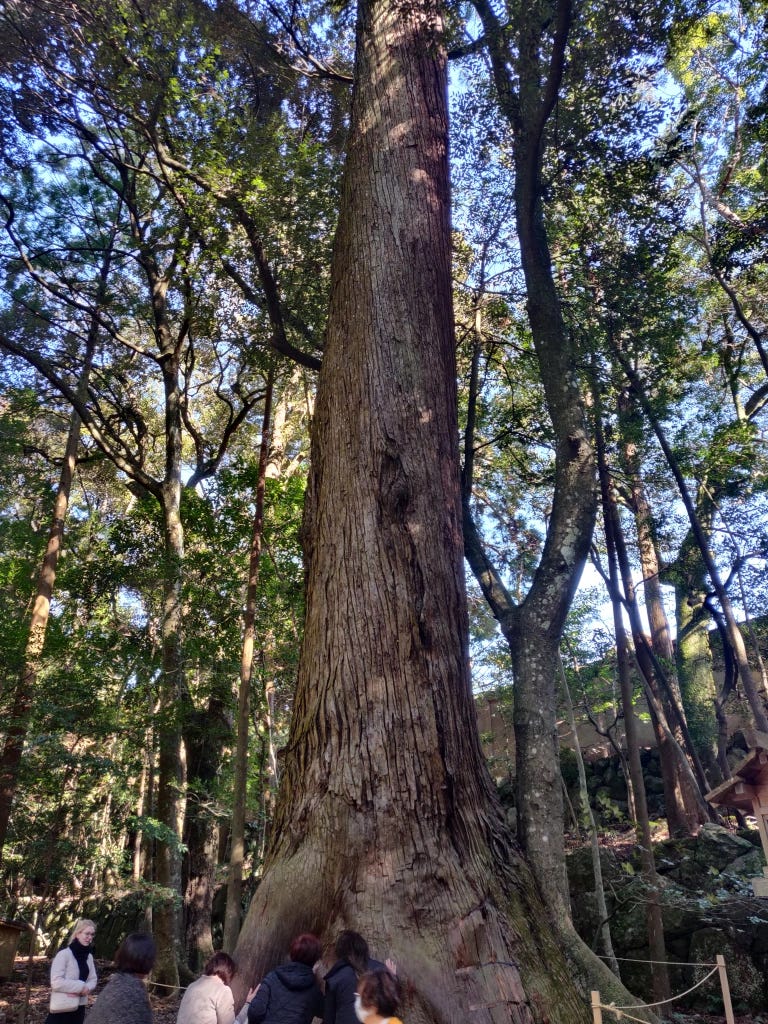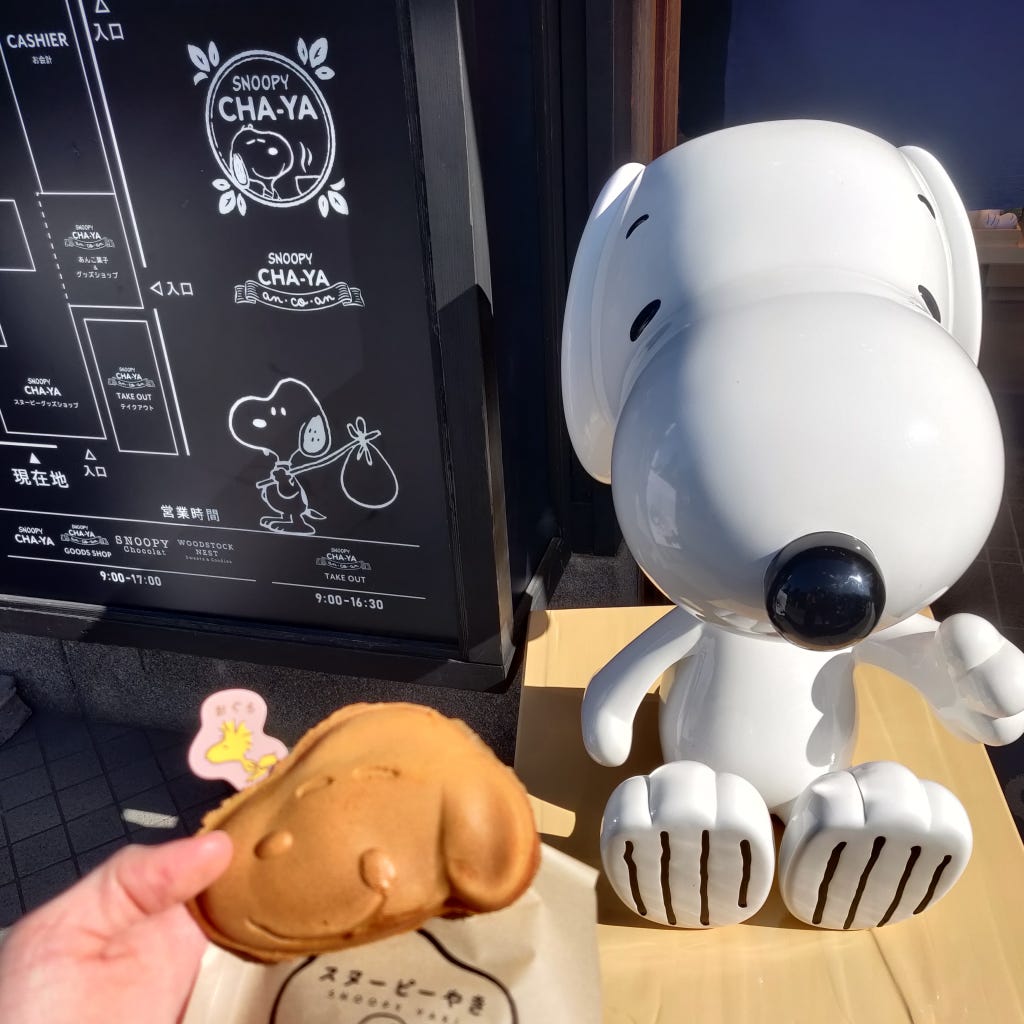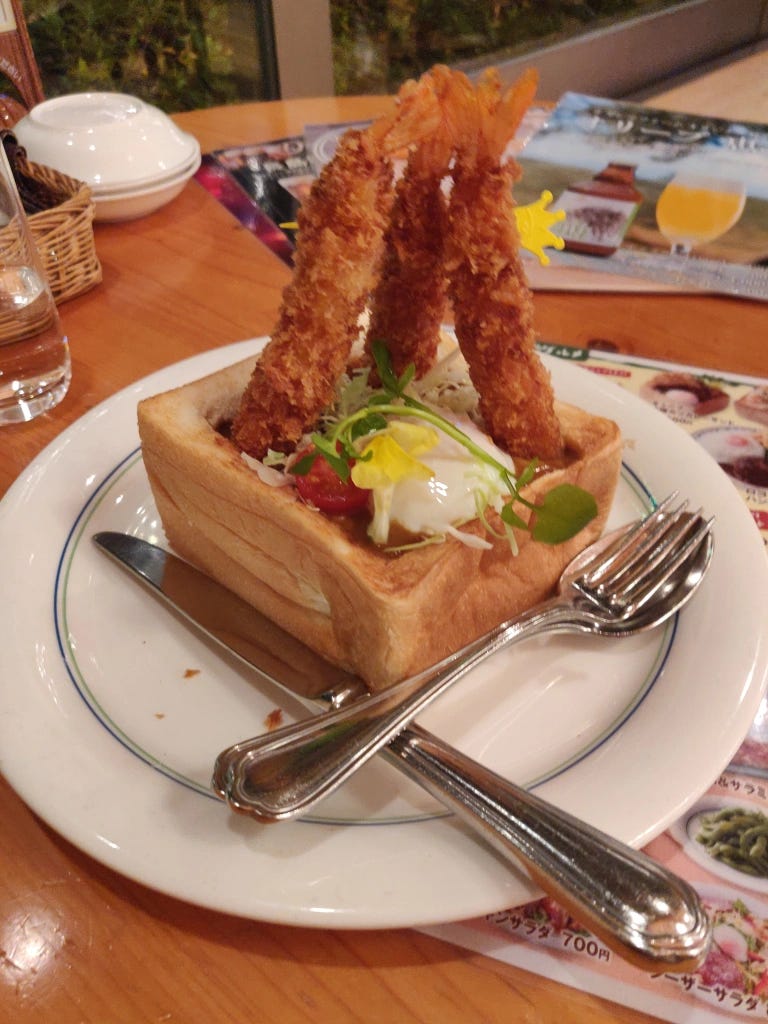I had a great day recently! Lemme tell you about it.
Ise Jingu
I wake up early, along with another workmate named Vanessa. She and I have the day off today, so we’re taking a train down to Ise, in Mie Prefecture. Ise is a small town by the water, built around the holiest places in the Shinto religion: a widespread complex of temples, collectively known as Ise Jingu. The two biggest sites are Naiku and Geku, the Inner and Outer Shrines, respectively. Naiku, the Inner Shrine, is dedicated to the sun goddess Amaterasu. Purportedly established in 4 BC, it is perhaps the most significant single shrine in all of Shinto. Geku, the Outer Shrine, is dedicated to the goddess of food and agriculture, Toyouke-hime. (The legend goes that Geku was built when the presiding Emperor saw Amaterasu in a dream: she said she couldn’t easily get food and requested that Toyouke be brought closer to her to take care of her meals.) There is now a twice-daily ritual in Geku where monks prepare and offer meals to the deities, which has gone unbroken for all 1500 years that Geku has stood.
We leave the hostel around 8:15am to catch the 8:50 train, direct from Nagoya station. An officer briefly told us to change seats for unclear reasons, but once we settled in, we turned a seat around and took in the gorgeous views.
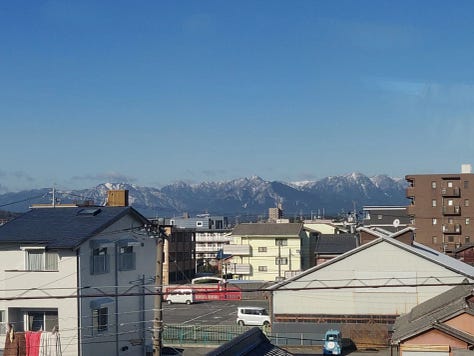
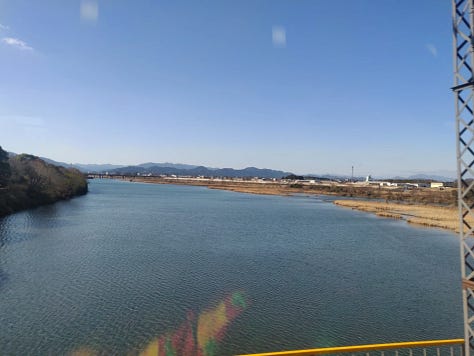
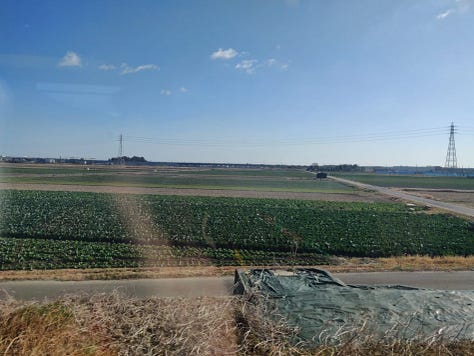
I also didn’t want to embarrass myself, so I looked up the proper procedure for ‘using’ a Shinto shrine. Here’s a quick summary:
The torii gate (⛩this thing) is the gateway to the realm of the kami (deities and spirits)—it’s their home, the least you could do is be polite. Bow once at the entrance before walking through. Always walk through it off-center, to the right or left (the center passage is reserved for the kami). On your way back out, turn around and bow again.
There is then a water basin with which to ‘purify’ your mind and body, called a temizuya, in which you perform the temizu ablution ritual: Take a wooden ladle and get some water. Pour some over your left hand, then your right. Then cup some in your left hand, drink it, then spit it out next to the basin. Then pour water over the ladle handle and put it back for the next guest.
Finally, at the shrine itself: walk up and toss a coin in the box/collection area. Clap twice, then bow twice. Say your prayers (not out loud), then bow once more and exit.
Seems easy enough!
The train arrives in Ise. Finding our way to the temple from the station was as easy as following the crowd. On the walk, I got some double and triple takes from older folks. In a less-urban place like this, I wonder how often they even see gaijin.
We make it to the temple grounds, and soon discover that we’re in Geku. We find the torii gate and water basin, and follow the procedures. (The water is cold but refreshing, and has no taste.) Then it’s a nice walk through a woodland trail before we see the shrines themselves. Instead of the bright-red you may expect, the Ise Jingu shrines and gates maintain their natural wood color, invoking an even older aesthetic.
We notice people taking pictures of a roped-off square, full of pebbles and one little box in the middle. It seemed like something was missing. Vanessa knows Japanese, so she asks someone what it is. As it turns out, the absence was the point: this was the site of the old shrine, right next to the actual rebuilt shrine just down the path.
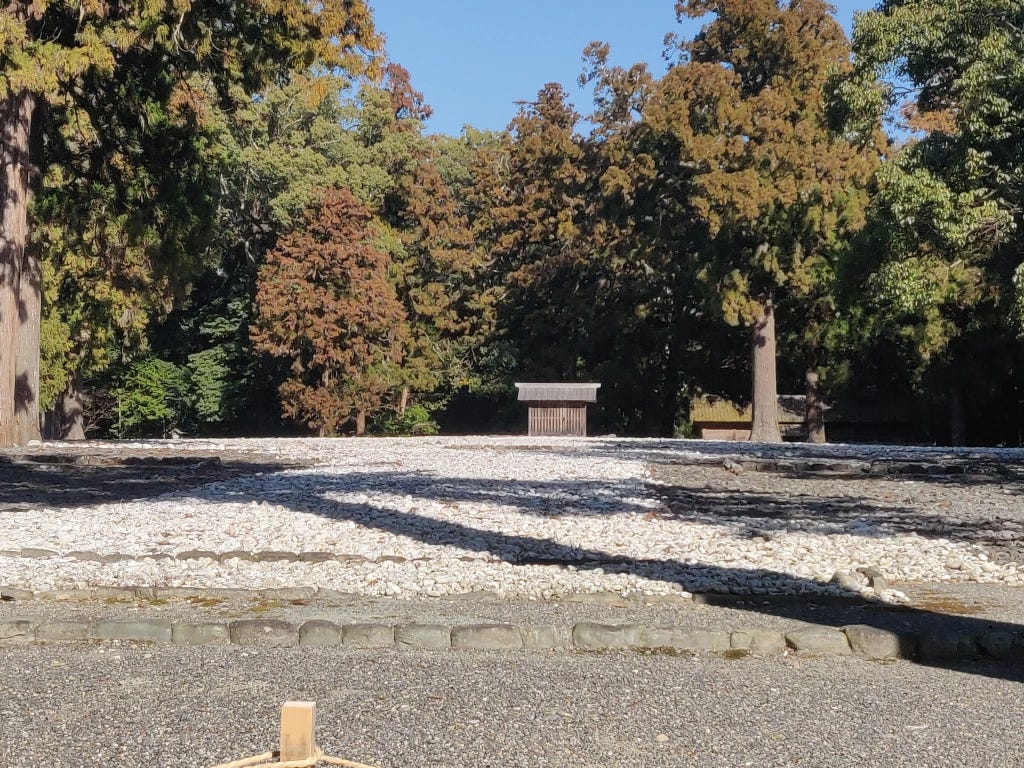
You may be wondering when and how the first shrine was destroyed, and when the new one was built. For one, the Jewish history of rebuilding our main temple is very important). But the Shinto monks here take a different approach: in order to pursue tokowaka (Shinto belief of everlasting youth, renewal, and pursuit of eternity), and to pass down the building techniques, the shrines at Ise Jingu are torn down and rebuilt every 20 years! This iteration of the temples was built in 2013!
An oxymoron makes itself clear: how is this place both 11 years old and 1600 years old? How is it that ‘ancient’ shrines were built so recently? That this sacred place came into being when Get Lucky was on the radio and House of Cards was watchable?
Aside from the aforementioned Shinto motivations, there’s something more vague and fuzzy to grasp at here, which seems to be a central tenet of Japanese culture: the power of the replica. In a place that values ancient tradition, no matter how delicate (think tatami floors, paper walls, etc), it stands to reason that preserving the “true” thing may not be feasible on a long enough timescale—but that doesn’t mean a replica is any less significant. In thinking this way, you notice that the significance may not be located in the object itself, but in the beliefs that are held by its builders and observers. Someone still knows the ancient building techniques, and can still teach them. Many tourists and citizens still know the history and significance, and to see a replica actually enforces its cultural importance (because if it wasn’t important, it wouldn’t have been replicated in the first place). This will probably come up again in future posts, so keep an eye out.
Along the paths through the woods, we come across several massive trees. The same man who educated us about the empty lot also tells us about their significance: they are Japanese cedar trees, hundreds of years old, planted long ago in the temple’s history (but still only half as old as the temple complex itself). It is believed, he says, that they contain the energy of the living earth and the kami within them—and even more so if the tree is leaning. “It’s under more stress,” he explains, “but it’s still alive. So there’s more energy.” Neat, it’s even got a lesson in perseverance baked right in. As we stood and listened, we saw several people press a hand or two to the monolithic cedar trunk and hold it there for several seconds before moving on. “They are feeling the energy.” And then, so was I.
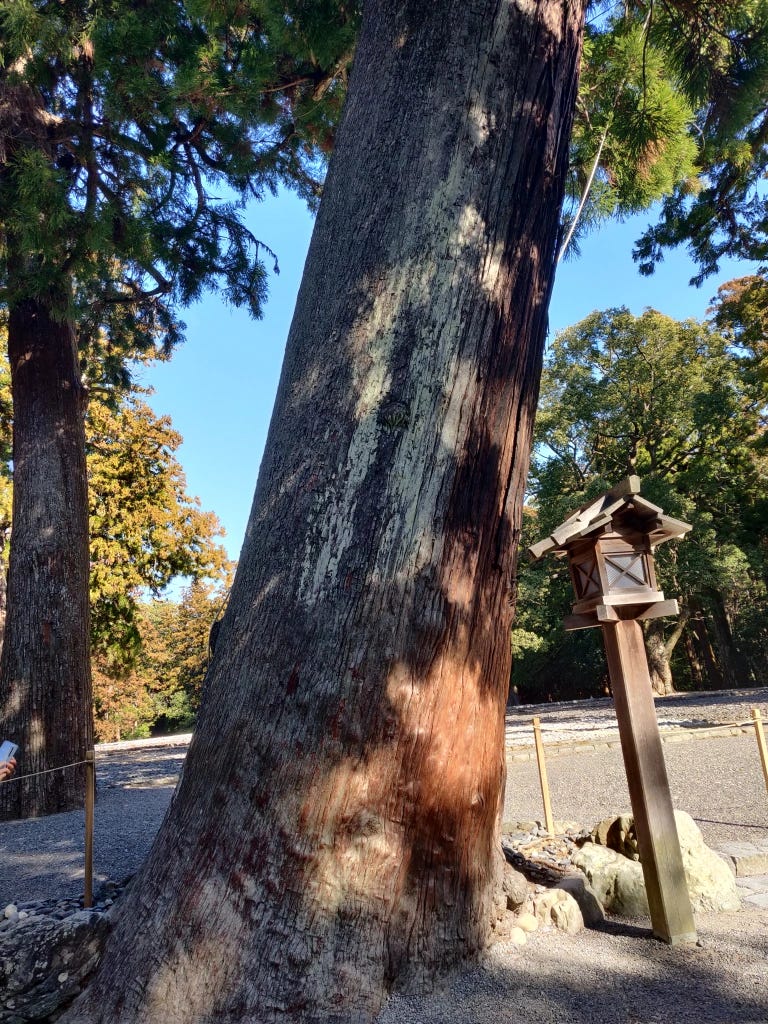
It felt smooth, well-worn by age and billions of hands. But I also felt something deeper. Looking up at the towering cedar, I thought of how much it’s seen, how many other forest lives it was connected to, spiritually and literally. I think it was around then that my psyche started buying into it, because I definitely felt some kind of grand significance.
Now onto the actual shrine—well actually, a complex of several shrines, all built in similar fashion out of solid cypress. Famously, the buildings have no metal fastening of any kind, only wood joinery. And each building has an empty lot right next door where its previous iteration once stood, and its next iteration will soon stand.
It’s a no-photo zone once we passed the torii into the main shrine. I take a coin in hand and get ready to pray.
A quick note: I don’t consider myself very religious in general. I am Jewish, and proud to belong to that culture, but I don’t strictly “believe in God”, nor do I fear him, and I don’t go to services or anything like that. However, I do have a strong drive to share in the experiences of those around me, to ‘do as the Romans do’, and it’s even stronger when compounded by millennia of tradition. My brief experience at the Western Wall, for example, was powerful enough that it left me in tears. So I felt like if I didn’t pray at least a little bit here, at the Shinto world capital, that I’d be missing out on something. I step aside for a moment and look up at the trees, and ask the Jewish God for forgiveness that I was praying somewhere else (it’s literally the First Commandment, I didn’t want to get in trouble). In response, I get a sense that He already knew what I was up to, and was totally fine with it. So I begin.
I don’t pray for much, just the stuff that comes to mind. Safe travels in this foreign land. Strong, positive, lasting relationships with the people here. And easy passage back home when the time comes. As I leave, I feel a kind of warmth in my gut, as if something settled down in my soul. It felt like I did the right thing. I’m not converting or anything, but I can’t deny what I felt.
Vanessa and I also catch a glimpse of a ceremony next to the shrine itself. A couple dozen suit-clad people watch as a monk, dressed in white robes, says prayers, then sweeps salt out of a bowl onto the ground (a ward from evil spirits, I believe). I didn’t realize it until I saw one woman wiping away tears: this is probably a funeral service. We stop gawking and walk on.
There are a few more shrines on different trails in the complex, but there was nothing indicating if the shrines were for certain tenets of the deities, or other spirits, or what. We observe from a distance and enjoy the nature, then decide it’s time for the Inner Shrine. It’s actually far away, it turns out, but a shuttle bus gets you there in 20 minutes.
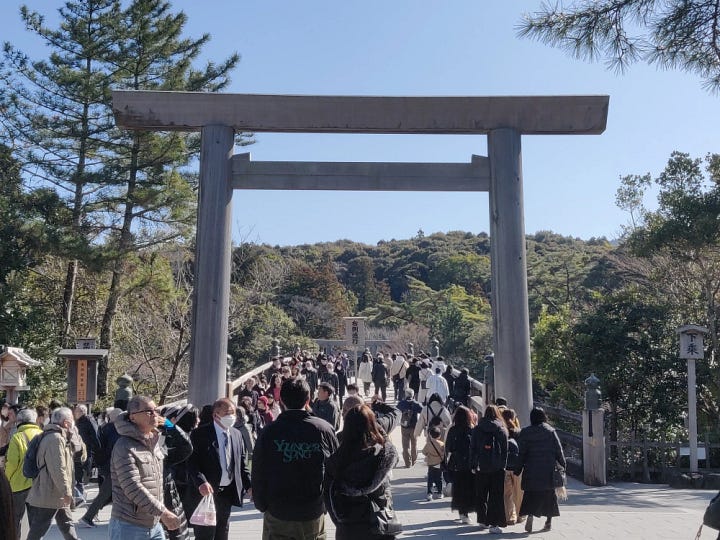
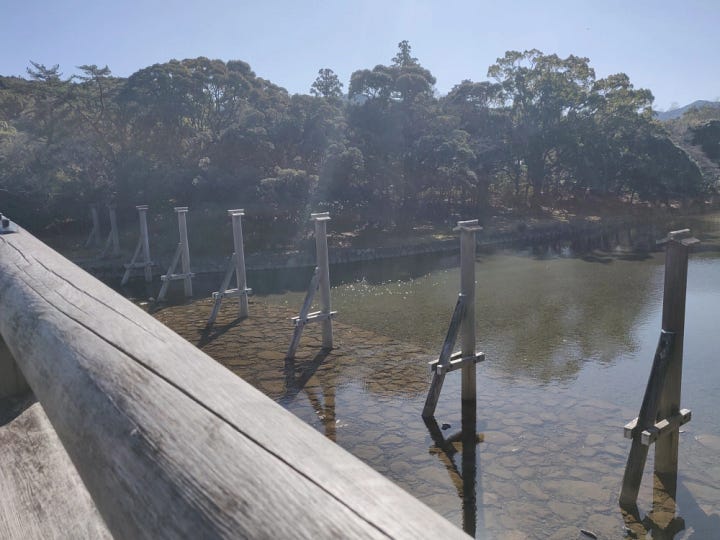
Visually, it’s more of the same, except for the Uji Bridge you cross on the way in (also rebuilt every 20 years!). More torii, water purification, and woodland paths. At the main Inner Shrine, I pray again, but I am at a loss for what to pray for—I feel like I covered it the first time. So I simply give thanks for letting me be there, and appreciate the life circumstances that led me to this point. The Inner Shrine complex has more humongous cedars, even older-looking than the others. Beyond just touching, some people fully hugged the trees—but they could only stretch their arms around a small part of the trunk.
We cross back over the bridge, turn around, and bow at the torii gate, to say goodbye to the spirit world. Back in the mortal realm, our hunger catches up with us. Luckily, right next to the shrine is a huge, bustling shopping street (shotengai) full of food, drinks, and knick-knacks. I learn pretty quickly that Ise, a coastal town, is proud of its seafood, especially mollusks like abalone and oysters. It also has lots of steak and beef places, and a fairly large craft beer presence.
Our first stop was a tea house, right at the start of the street—a local specialty is mochi surrounded by red bean paste, and Vanessa wanted to try some. (I don’t like mochi very much, the texture is too squishy/pasty for me.) It tastes fine, but the tea they served with it was delicious: maybe it was my empty stomach, or the rest from walking, or something, but those first few sips warmed me up inside like nothing else—like it was blessed by the food goddess herself. I choose to believe that my prayer was answered. We walked on and filled our stomachs as we went, and everything there was delicious too. Thanks, Toyouke-hime!
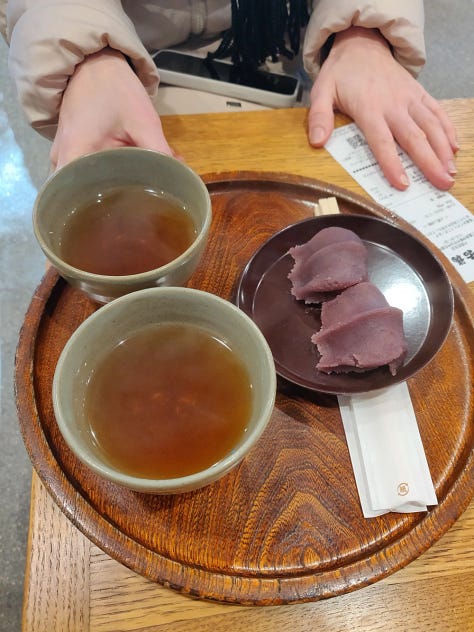

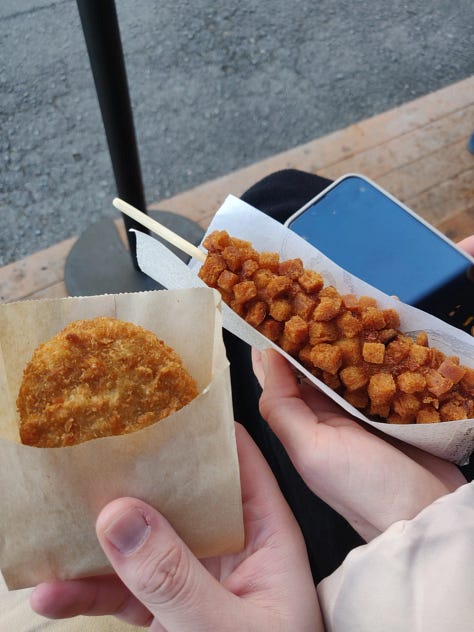
Nabana no Sato
Vanessa and I make it to the train back to Nagoya. She’s going home, but I have one more stop: Nabana no Sato, a botanical garden with beautiful light displays. One of my favorite places back in America is Longwood Gardens, which is the same concept, and I couldn’t resist seeing how they compare.
During flowering seasons, Nabana no Sato boasts huge fields of tulips and other flowers—but it’s winter. No matter! Their indoor Begonia garden is in bloom year-round, and it has some breathtaking rooms:

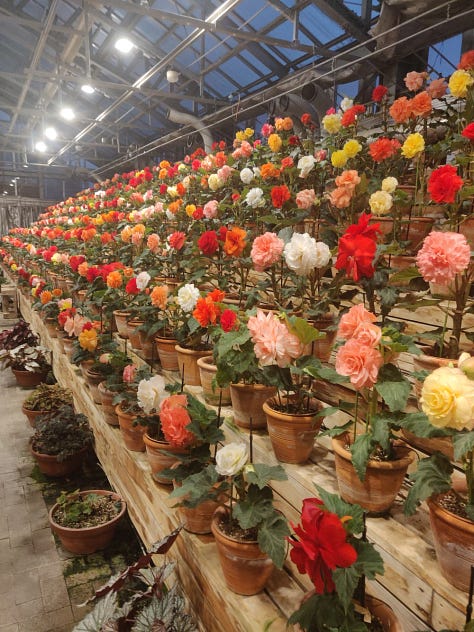
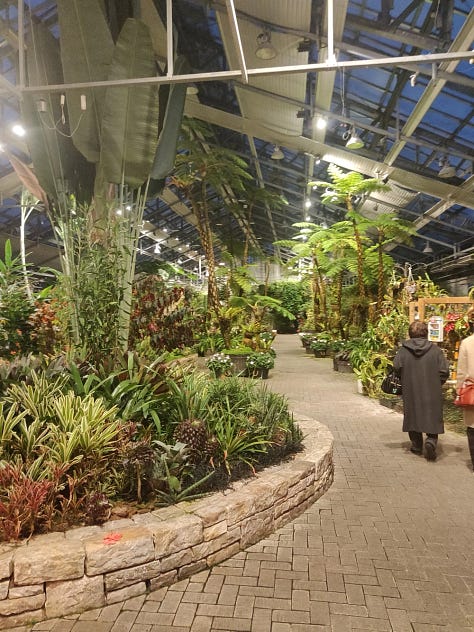
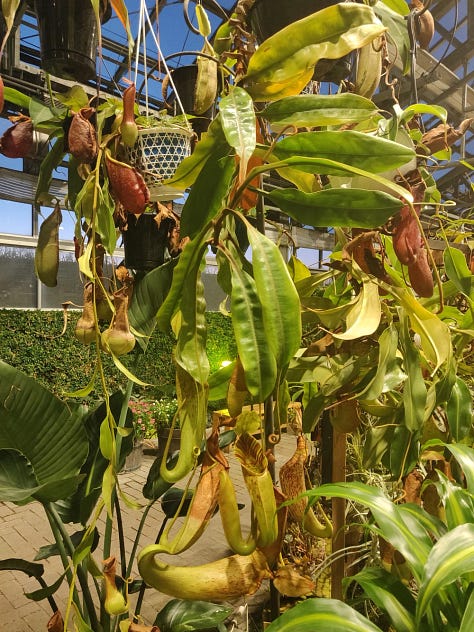
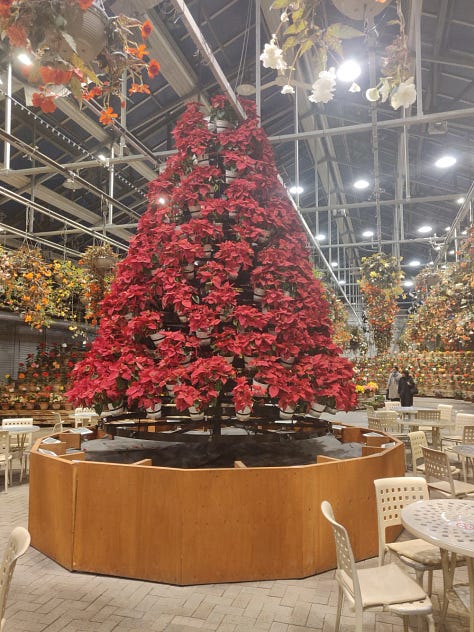
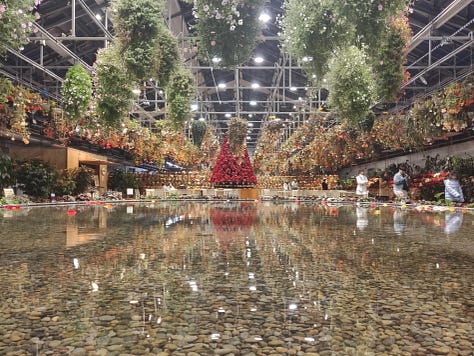
It’s fully dark by the time I leave the indoor garden, just in time to see the lights. The two most popular attractions are the Tunnel of Light, which is what it sounds like, and the Main Illumination, which apparently has a different theme every year. This year, it’s ancient Egypt: they constructed three huge pyramids of scaffolding for lights, with more lights all around them. The entire area runs an 8-minute presentation on loop with music in the background.
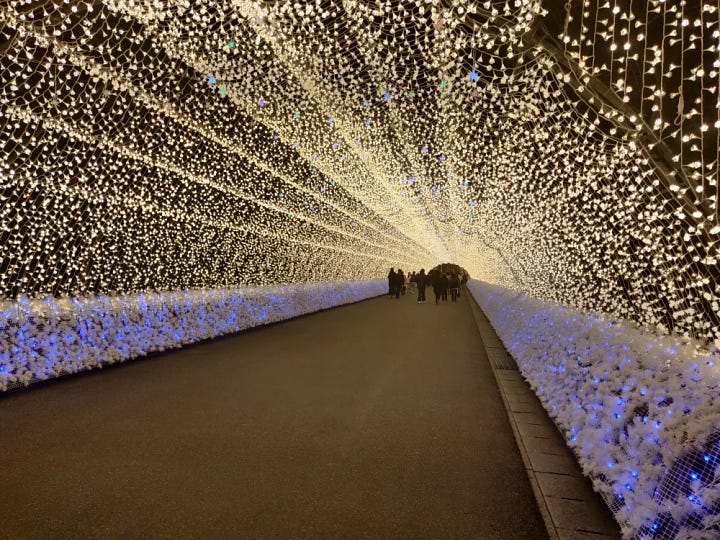

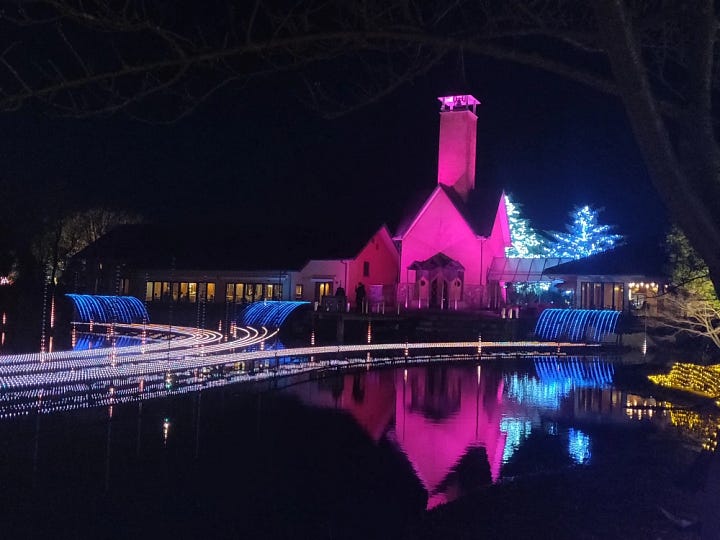
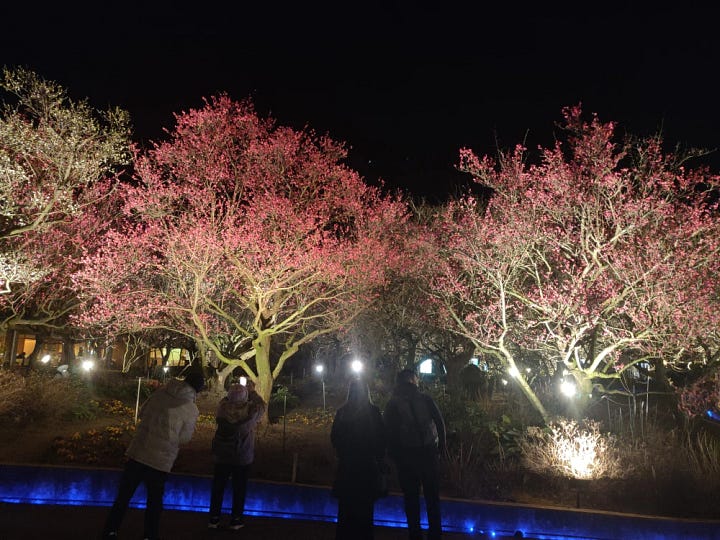
On the premises are several restaurants, ranging from mid-tier to fancy. Part of the cost of a ticket to Nabana no Sato includes a voucher to spend on food and souvenirs, which is a nice business model. I use them on this:
Finally, hidden next to a walking path is a real treat: a foot onsen. Onsens are baths filled with flowing natural hot-spring water, found all over Japan—but this one is just to dip your feet into. It’s the perfect place to rest for a while before the journey home. It was very hard to leave, but once I did, I was walking on new legs.
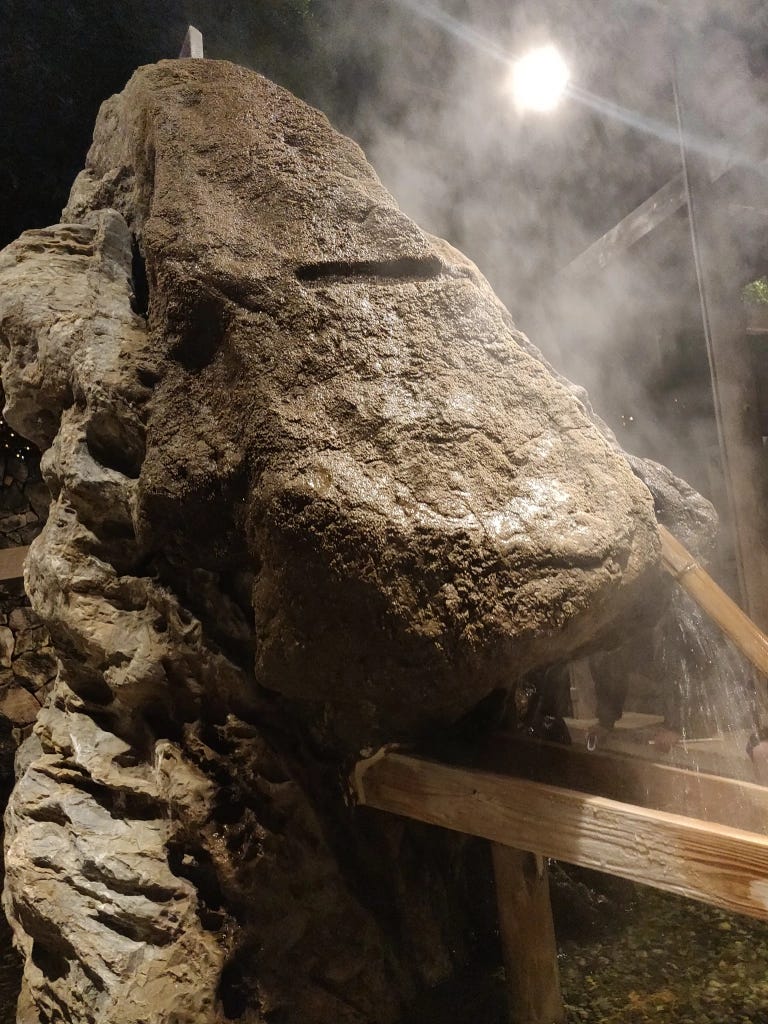
And this was great, because I would come to hit a snag at the train station—I am out of cash.
Out of cash
Japanese transportation infrastructure is very smooth and seamless (at least to the untrained eye of the tourist). So what’s it like when you run into an obstacle? Honestly, I feared it would be much worse than it was.
The problem: I can’t get cash from an ATM, I forgot my debit card in the States. I have my credit card, but American credit cards don’t come with a PIN like debit cards do. Apparently this is strange, because the ATM (and my European workmates, and the bank I asked to help) all expect my credit card to have a PIN. I call my card company to see if they can issue me a PIN. They say they’ll send it in the mail to my home address (in the States) and it will take a couple weeks. (Spoiler alert: still nothing, at time of writing.)
The consequences: only some places in Japan accept credit card. Sadly, this does not include most train stations, including the one closest to Nabana no Sato. Without any cash, I was stuck behind the gate, watching my train leave without me. (This part isn’t a problem—trains run very frequently, the next one here arrives in 20 minutes.)
I pace back and forth and weigh my options. I could bother a stranger for ticket money, but I know how that looks from the other side, and it’s unlikely to work. I try it anyway on one couple, showing a translated message on my phone, and they just say “sorryyy” and walk away. I don’t blame them. Eventually I notice an intercom next to the ticket kiosk, and get up the courage to press the call button. I prep a message on my phone to recite in case they don’t know English, but luckily my question of “eigo?” gets a “Yes” in response. After explaining my situation, there are a few brief pauses where he processes my information, and I’m unsure what will happen. But soon the gate opens with an override buzzer sound, and I walk through. It felt strange to leave the intercom behind and not be able to thank him.
Back at Nagoya station, at the exit gate, I explain my situation again to the officer there (in person this time), and say I want to pay for my ticket. He escorts me through the exit gate to another row of receptionists, and tells them what’s going on in Japanese. I pay them with my credit card. The first officer takes the ticket, walks back to the exit gate, feeds the ticket in, and gives me a thumbs-up. All is well, and my new first priority is to get cash ASAP.
Despite this hurdle at the end, this was one of my favorite days in Japan so far. The prayers felt meaningful, the food was fantastic, and the light displays were dazzling. A feast for the eyes, soul, and stomach.
I’ll be covering more day-trip experiences like this in future posts, when I can find the time. Thanks for your patience, and I’ll see you on the next adventure!

